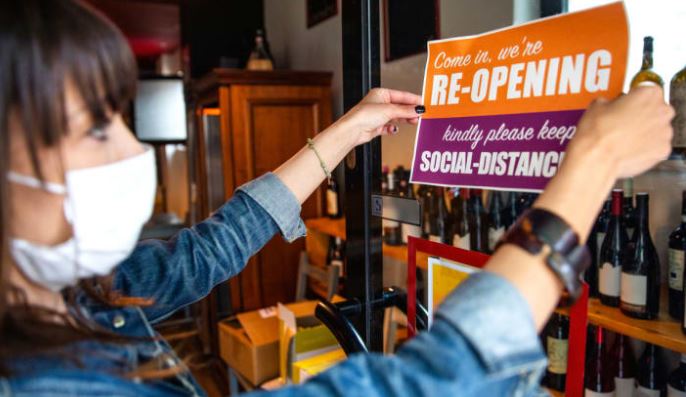The Paycheck Protection Program (PPP) aims to help struggling businesses keep workers employed during the COVID-19 crisis. Employers that received loans through the program last year may be eligible for a second loan if they meet certain criteria.
Congress passed the Consolidated Appropriations Act, 2021 (CAA) in December 2020, which included a $900 billion COVID-19 economic relief package. Among other provisions, the CAA extended and modified the PPP.
The program provides small businesses with “the resources they need to maintain their payroll, hire back employees who may have been laid off, and cover applicable overhead,” according to the U.S. Treasury Department.
Eligible employers can now apply for a first or second PPP loan through March 31.
Eligibility Requirements
“Small businesses and eligible nonprofit organizations, veterans organizations and tribal businesses described in the Small Business Act, as well as individuals who are self-employed or are independent contractors, are eligible if they also meet program size standards,” according to the U.S. Small Business Administration (SBA), which administers the program.
Most businesses are eligible for a first loan if they employ fewer than 500 employees. However, businesses that employ more than 500 workers may be eligible if they meet the SBA’s size standards for their industry.
Employers may be eligible for a second draw if they:
- Have no more than 300 employees.
- Already received a first draw PPP loan and used the full amount only for authorized uses.
- Can show at least a 25 percent reduction in gross receipts between comparable quarters in 2019 and 2020.
A key change is that borrowers don’t have to keep their employee headcount and wages at pre-pandemic levels to have their loan forgiven if they certify that they had to cut staff to comply with federal guidance on “sanitation, social distancing or any other work or customer safety requirement related to COVID-19,” explained Angelo Filippi, an attorney with Kelley Kronenberg in Fort Lauderdale, Fla. “It also expands on the expenses that would qualify for loan forgiveness to include the cost of safety gear for employees, erection of barriers and other space alterations necessary to comply with social distancing guidelines.”
Applying for Forgiveness
PPP loans cover an eight- to 24-week period. Employers can apply for loan forgiveness if the following criteria are met during the covered period:
- Employee headcount and pay levels are maintained.
- Loan funds are spent on payroll costs and other eligible expenses.
- At least 60 percent of the funds are spent on payroll costs.
For the second draw, employee headcount and compensation levels must be maintained in the same manner as required for the first draw.
“Employers should look closely at the loan forgiveness applications and the instructions,” said Patrick Dennison, an attorney with Fisher Phillips in Pittsburgh. “Take the time to do a run-through of the application before reaching the end of the covered period. If there is something you do not understand about the application, consult with an industry professional—whether an attorney or CPA—before the time comes to complete and submit for forgiveness.”
Michael Mahoney, an attorney with Ogletree Deakins in Morristown, N.J., said employers should start contemplating loan forgiveness before they receive their loan disbursements.
Set up a separate bank account for the PPP loan distribution, he said. “That will streamline a borrower’s ability to track how each dollar of the loan is spent.”
Borrowers should contact their vendors to review any available reporting features that may help them document the permitted payroll and nonpayroll costs during the covered period, he added.
“Payroll records are key,” Filippi noted. For full forgiveness, employers must show that employees retained during the eight- to 24-week period were paid at least 75 percent of their pre-pandemic wages and that 60 percent of the PPP loan was used to fund payroll.
Employers should keep copies of canceled checks, bank statements, utility bills, mortgage statements and lease agreements to prove that payments were made for covered expenses.
“We always encourage employers to document, document, document,” said Brent Beckert, an attorney with Haynes and Boone in Dallas. Borrowers also should keep an open line of communication with their lenders and keep them in the loop on any judgement calls made in the application or forgiveness process, he said. “This will allow borrowers to fix issues before submitting their applications to the SBA and avoid unnecessary surprises later.”
Common Mistakes
Employers should carefully review information on the SBA and Treasury Department websites. “The most common mistake employers make concerning PPP loans is failing to keep up with the changes in rules or guidance,” Dennison noted.
Employers also err by approaching the PPP loan process as if they will not be audited. “In my opinion, employers should do the opposite and approach the process as if an audit is forthcoming,” Dennison said. “Employers should be proactive, careful and thoughtful in preparing documents and records related to PPP loans.”
Some borrowers do not look at the loan forgiveness application or their own data until after the conclusion of the covered period. This may limit a borrower’s ability to implement strategies to take advantage of the various safe harbors or exceptions to rules that reduce the amount of the loan that may be forgiven, Mahoney said.
Other borrowers do not maintain PPP loan records in a centralized location, which causes them to scramble to collect the information needed when they are completing the loan forgiveness application.
“In some instances, employers have not been able to find documents to substantiate unique situations, like bona fide offers to rehire terminated employees that were refused or employee requests for reduced hours,” Mahoney observed.
Some employers have avoided making reductions to their workforce out of fear of losing eligibility for loan forgiveness. Filippi explained that businesses may receive a proportionate loss in forgiveness, which can be adjusted if they offer reinstatement. “Remember that even without forgiveness of the entire loan, the terms for paying off PPP loans are extremely favorable,” Filippi said.
